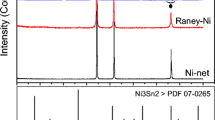Abstract
The partial dissolution of zinc from electrodeposited Ni-Zn alloys (withX 0Zn =22–87.3 mol %) was studied, in cold and nearly boiling 10m KOH. It was found that alloys withX 0Zn ≤22 mol % are not dissolved at all. The dissolved zinc fraction,A, increased rapidly with further increase in zinc content and after having passed a maximum withA=82–90% atX 0Zn =55–58 mol % and a sharp minimum withA=52–65% atX 0Zn =65–69 mol %, it asymptotically approached toA → 100% atX 0Zn → 100 mol %. The discontinuous dependence ofA againstX 0Zn may be explained by differences in the crystallographic composition of the alloy deposits. Alloys withX 0Zn <50–60 mol % can be allocated to solid solutions of zinc in the Ni matrix (α-phase); the range of 50–60<X 0Zn <70–80 mol % corresponds to the coexistence of α+γ phases. The pure γ-phase exists within a narrow range atX 0Zn =75–80 mol %. No zinc dissolution from Ni-Zn alloys withX 0Zn ≤22 mol % was explained by extremely low zinc activities in dilute solid solutions of the α-phases shifting the Gibbs energy of the dissolution reaction to very low negative, or even to positive values. The dependence of the hydrogen and oxygen overvoltage atj=0.4 A cm−2 in 10m, KOH at 100°C on the original zinc contentX 0Zn showed, in both cases, a clear minimum atX 0Zn =75–78 mol %. This points to a practically pure γ-phase in the original Ni-Zn alloy with an approximate composition NiZn3.
Similar content being viewed by others
References
J.Balej, J. Divisek, H. Schmitz and J. Mergel,J. Appl. Electrochem. 22 (1992).
Y. Choquette, L. Brossard and H. Ménard,20 (1990) 855.
K. Sasaki and K. Sugiyama,Kogyo Kogaku Zasschi 60 (1957) 387.
I. Paseka and J. Balej,Chem. prům. 20 (1970) 305.
J. Balej,Int. J. Hydrogen Energy 10 (1985) 89.
J. Divisek, H. Schmitz and J. Balej,J. Appl. Electrochem. 19 (1989) 519.
G. Schwitzgebel, J. Lang and R. Sass,Z. Phys. Chem. (N.F.) 146 (1985) 87.
A. Brenner, ‘Electrodeposition of Alloys'’ Vol. II, Academic Press, New York (1963) pp. 194–238.
D. E. Hall,Plat. Surf. Finish. 70 (1983) 59.
M. Hansen and K. Anderko, ‘Constitution of Binary Alloys'’ 2nd Ed., McGraw-Hill, New York (1958) p. 1060.
E. P. Schoch and A. Hirsch,Trans. Electrochem. Soc. 11 (1907) 135.
N. T. Kudryavtsev, T. G. Smirnova and O. P. Volkova,Prot. Met. 2 (1966) 597.
P. M. Vyacheslavov, G. B. Kabanov, M. M. Bodyagina and A. O. Bodyagin,J. Appl. Chem. (USSR) 57 (1984) 1191.
J. Divisek, Water electrolysis in a low- and medium-temperature regime, in ‘Electrochemical Hydrogen Technologies. Electrochemical Production and Combustion of Hydrogen’ (edited by H. Wendt), Elsevier, Amsterdam (1990) pp. 137–212.
J. Divisek, J. Mergel and H. Schmitz,Int. J. Hydrogen Energy 7 (1982) 695.
J. Divisek, J. Mergel and H. Schmitz,15 (1990) 105.
Author information
Authors and Affiliations
Rights and permissions
About this article
Cite this article
Balej, J., Divisek, J., Schmitz, H. et al. Preparation and properties of Raney nickel electrodes on Ni-Zn base for H2 and O2 evolution from alkaline solutions Part II: Leaching (activation) of the Ni-Zn electrodeposits in concentrated KOH solutions and H2 and O2 overvoltage on activated Ni-Zn Raney electrodes. J Appl Electrochem 22, 711–716 (1992). https://doi.org/10.1007/BF01027498
Received:
Revised:
Issue Date:
DOI: https://doi.org/10.1007/BF01027498




